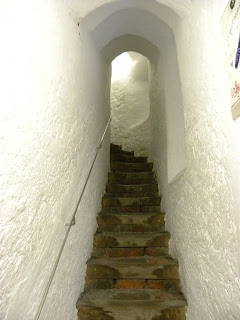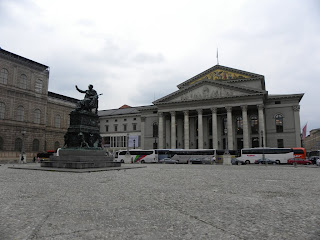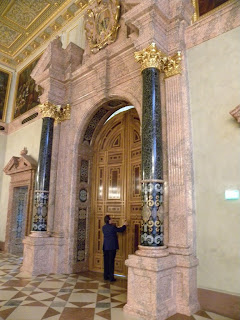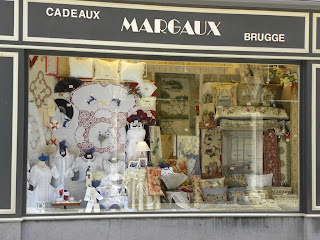Brugge, the capital of "West-Vlaanderen" in Belgium is part of the UNESCO World Heritage list. As a small city with approximately a population of 120.000 people, they brew many different beers and the most famous are: "Brugse Zot", "Brugge Trippel", "Brugs Tarwebier" and "Straffe Hendrik". In Brugge you find many canals, called the Reien, good for a guided boat trip and if you don't like water you can enjoy a ride with a horse and carriage. There are so many architectural treasures you don't know what to visit first. One of the main shopping streets is the Zuidzandstraat. If you are looking for a local souvenir, lace could be something for you.
Below you find already some pictures but my next articles will be about some of the main attractions of Brugge:
- the Basilica of the Holy Blood.
- the city hall.
- the church of Our Lady.
- the main square and its Belfry.
Brugge is de hoofdstad van West-Vlaanderen (België) en werd opgenomen op de UNESCO Werelderfgoedlijst. Het is een kleine stad met ongeveer 120.000 inwoners en ze brouwen hier ook vele bieren waarvan de meest bekende "Brugse Zot", "Brugge Trippel", "Brugs Tarwebier" en "Straffe Hendrik" zijn. In Brugge zie je overal kanaaltjes, de Reien, waar je met een bootje onder begeleiding de stad kan bezoeken. Als je niet van water houdt kan je nog kiezen voor een ritje met paard en koets. Er zijn zoveel historische schatten dat je niet weet wat eerst te bezoeken. Ook winkelen behoort tot de mogelijkheden, bijvoorbeeld in de Zuidzandstraat. Als je zoekt naar een typische souvenir is het Brugse kant misschien iets voor jou.
Hieronder vind je al een paar foto's maar mijn volgende artikelen beschrijven enkele van de belangrijkste bezienswaardigheden van Brugge:
- de Heilig-Bloedbasiliek.
- het stadhuis.
- de OLV kerk.
- de grote markt en het Belfort.
Return to main page
One of the effective ways to decrease the expenditure is to go for mini bus hire or coach hire. There are various advantages of hiring minibus while you are travelling. This is the best option if you are going out with your friends and family or in a large group. This is because of the reason that some of the hiring agencies give discounts and offers which will help you save money and time.
Monday, May 31, 2010
Sunday, May 30, 2010
El Complejo de Wawel, Cracovia
 Junto al rio Vistula en Cracovia pero elevado 25 m sobre el nivel del rio se encuentra una colina en la que encontramos el Complejo llamado Wawel.
Junto al rio Vistula en Cracovia pero elevado 25 m sobre el nivel del rio se encuentra una colina en la que encontramos el Complejo llamado Wawel.Es uno de los lugares más bellos de Polonia y simbolo de gran valor para los polacos. Wawel está formado por el Castillo Real, la Catedral, Museo de la Catedral y la fortificación.
La Catedral y el Castillo fueron construidos en el siglo XIV y ambos forman parte del Patrimonio de la Humanidad por la UNESCO desde 1978.
La primera foto la hice desde el exterior, en ella se puede ver el renovado sistema de fortificación y parte del Castillo Real.
La foto de bajo es uno de los dos accesos al complejo, aquí se puede ver la Torre Sandomierz, una de las tres torres de la segunda mitad del siglo XV que servia de defensa:

Este es el otro acceso al complejo, fortificación del siglo XVII en la que vemos la Puerta Vasa, coronada con un monumento a Tadeusz Kosziuszko (heroe nacional del siglo XVIII):

Peldaños de acceso a Wawel:

Una vez en el interior de Wawel nos dirigimos a su parte central desde la que podemos contemplar la Catedral de San Wenceslao y San Estalisnao:

La Catedral de Wawel es la mayor iglesia gótica de Polonia y una de las más importantes, en su interior hay tumbas reales y durante los últimos 500 años han sido enterrados los principales líderes polacos. El pasado abril de 2010 fue enterrado Lech Kaczynski (presidente de Polonia fallecido en la catástrofe aérea de Smolensk).
Entrada principal a la Catedral:

Vista de las Torres de la Catedral:

En la Catedral se encuentra la Campana de Segismundo que es la mayor de toda Polonia con un peso de 11 toneladas y 2 m de diámetro.
Parte de la Catedral vista desde el exterior:

Torre del reloj de la Catedral:

Lo que más me gustó fue el Castillo Real, recomiendo la visita guiada en la que se explica ampliamente (en ingles) el interior de las salas.
Se encuentran en ellas el Tesoro Real y Armeria Real, colecciones orientales, enormes tapices fabricados en Bélgica.
Importante también es el techo del Salón de las Audiencias en las que hay muchas cabezas talladas decorando el techo.
Esta es una parte del enorme patio central del Castillo Real de Wawel:

Edificio frente al Castillo en el que pude hacer la foto cuando pasaba un carro tirado por caballos dándole un aspecto de lugar un siglo atrás:

Desde el Castillo se puede ver el rio Vistula a sus pies:

Se puede bajar el Castillo por una torre que conduce a la gruta del Dragon. Una vez bajo, se ve una pequeña excavación subterranea y parte de muro antiguo de fortificación en la que al salir encontramos el Dragon de Wawel. Cuenta la leyenda que el Dragon atemorizaba a los habitantes, que lo calmaban dejandole comida a la entrada de la cueva. Un dia, un hombre mató un cordero, lo vació y lo rellenó con azufre y se lo ofreció al Dragon. Este se lo comió y le entró tanta sed que bebió del Vistula hasta que murió. El rey como premio le entregó la mano de su hija.
En la parte inferior se ve el monumento al Dragon de Wawel en el que cada cierto tiempo (calculo que serian 5 minutos) proyecta fuego por la boca:
Bonito/a
We've recently upgraded our fishing reels and lines for the wish of catching some of those huge tunas we had on the hook a couple of times but were to big to reel in. So far only Sea bass, Bonito's and Mackerel's, caught. Still waiting for the big ones. This is the dinner for tonight. A beautiful 1500 g's Bonito. /Alex
Saturday, May 29, 2010
St. Peters Church, München
The St. Peters church in Munich is located near Marienplatz. In the church you find colourful wall paintings and statues. Contrary to many other churches there is a lot of light inside. The tower is also open for visitors. After a climb of 14 stories, on foot, you have the best view over Munich. It's a pity it was raining but I still took some pictures of the spectacular view of Marienplatz, the Frauenkirche and Viktualienmarkt. Make the climb it is worth it.
De St. Pieters kerk in München is gelegen dichtbij de Marienplatz. Binnen in de kerk zie je veel kleurrijke muurschilderijen en beelden. In tegenstelling tot vele andere kerken is er hier veel lichtinval. De kerktoren is ook open voor bezoekers. Na een klim van 14 verdiepingen, te voet, vind je er het beste panoramisch zicht over München. Het is spijtig dat het regende, maar toch heb ik spectaculaire foto's genomen van de Marienplatz, de Frauenkirche en Viktualienmarkt. Maak de klim, het is het waard.







Previous Munich article: Residenzmuseum, Munich
Return to main page
De St. Pieters kerk in München is gelegen dichtbij de Marienplatz. Binnen in de kerk zie je veel kleurrijke muurschilderijen en beelden. In tegenstelling tot vele andere kerken is er hier veel lichtinval. De kerktoren is ook open voor bezoekers. Na een klim van 14 verdiepingen, te voet, vind je er het beste panoramisch zicht over München. Het is spijtig dat het regende, maar toch heb ik spectaculaire foto's genomen van de Marienplatz, de Frauenkirche en Viktualienmarkt. Maak de klim, het is het waard.







Previous Munich article: Residenzmuseum, Munich
Return to main page
The Cocktail Drinkers' Guide to Gardening: May
Originally from Hampshire, England, James Clay is an artist and sculptor who has lived in St. Remy for almost 20 years. He knows pretty much everything about gardening in Provence. Plus, he likes to drink...and write. (Often at the same time, of course.) Each month here on ProvencePost.com, James serves up gardening tips and ideas...with appropriate drink suggestions. This month, he's just back
Thursday, May 27, 2010
Garraf
One of those nights last week, before sailing up towards Costa Brava, we decided to leave Barcelona for a night. We looked forward to a quiet dinner on the sea and the great feeling of waking up somewhere else than our own harbor. So we set sail to Garraf, a small town just before Sitges.
Salmon and potato salad, some cheese and a nice fuet, a wonderful bottle of wine and the magnificent view of the city.
Early morning in the Garraf marina.
Took a short promenade up in the town.
Had breakfast under the palm trees..
Visited the church..
.. and admired the sea from a distance while walking back to the boat for a relaxing morning sail back home. Every time we're out like this we say: Why don't we leave now? What if we didn't have to turn back home? It's a frustrating feeling of going somewhere wonderful, getting there, wanting more of it, to get further down South.. but then have to return. What a divine day it will be, the day when we will be able to say goodbye for the last time for many months. /T
Wednesday, May 26, 2010
Residenzmuseum, München (The Munich Residence)
The Munich residence was the palace and the political centre for the government and kings of Bavaria. This palace was used from 1623 till 1918 and there are approximately 130 rooms. The palace has many architectural styles because it was build and adjusted during several centuries. The residence was destroyed during World War II and afterwards rebuild. For me, the most impressive rooms are: the Imperial Hall, the Green Gallery and the Antiquarium. When you have time to visit only 1 museum or castle in Munich, I would recommend to going to the Residence.
De Residenz in München was het politieke en koninklijke centrum van Bavaria voor vele eeuwen. Het werd gebruikt van 1623 tot 1918 en heeft ongeveer 130 kamers. Omwille van de persoonlijke voorkeur van vorsten en de lange bouwperiode over verschillende eeuwen, bestaat dit kasteel uit verschillende bouwstijlen. Het paleis werd vernietigd op het einde van de Tweede Wereldoorlog en achteraf heropgebouwd. De kamers die de meeste indruk op mij gemaakt hebben zijn: de keizerlijke hal, de groene galerij, en het Antiquarium. Als je enkel tijd hebt voor 1 museum of kasteel te bezoeken in München, zou ik u aanbevelen naar de Residenz te gaan.








Previous Munich article: Olympiapark, Munich
Return to main page
De Residenz in München was het politieke en koninklijke centrum van Bavaria voor vele eeuwen. Het werd gebruikt van 1623 tot 1918 en heeft ongeveer 130 kamers. Omwille van de persoonlijke voorkeur van vorsten en de lange bouwperiode over verschillende eeuwen, bestaat dit kasteel uit verschillende bouwstijlen. Het paleis werd vernietigd op het einde van de Tweede Wereldoorlog en achteraf heropgebouwd. De kamers die de meeste indruk op mij gemaakt hebben zijn: de keizerlijke hal, de groene galerij, en het Antiquarium. Als je enkel tijd hebt voor 1 museum of kasteel te bezoeken in München, zou ik u aanbevelen naar de Residenz te gaan.








Previous Munich article: Olympiapark, Munich
Return to main page
Subscribe to:
Comments (Atom)










